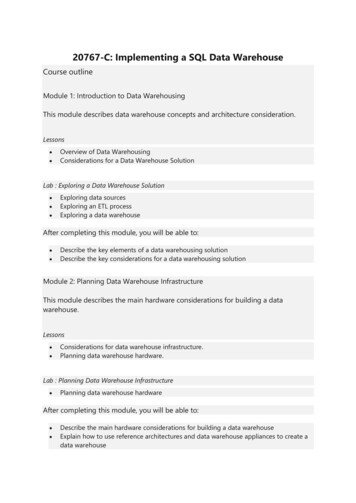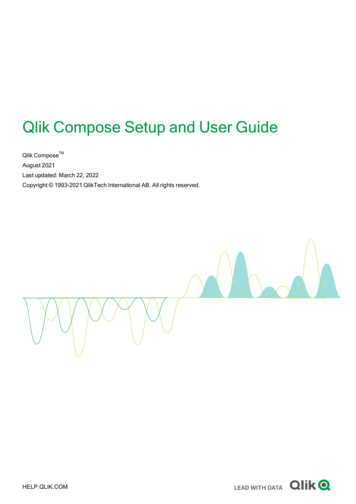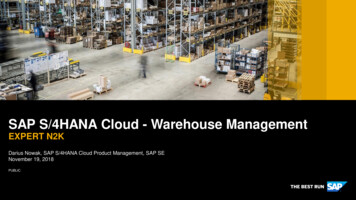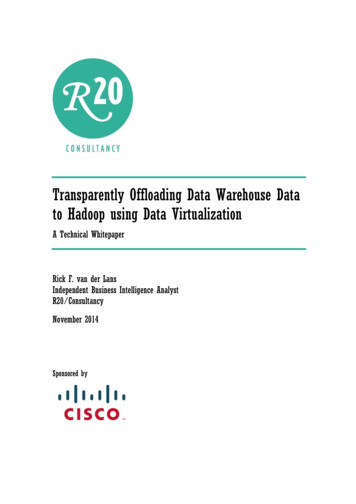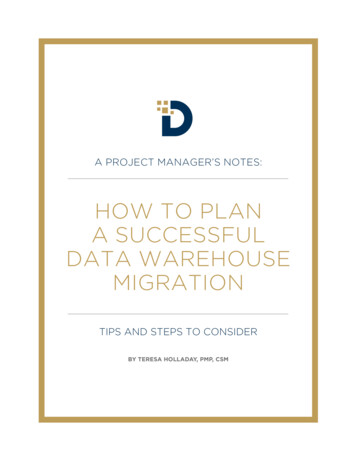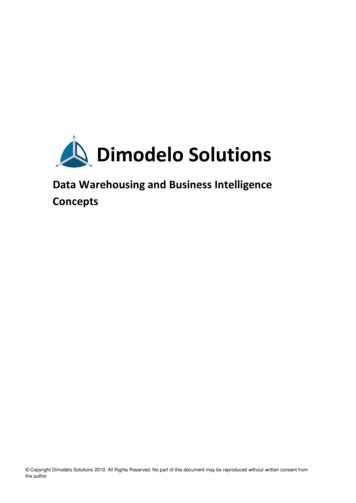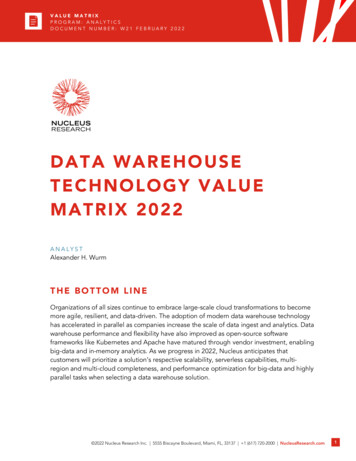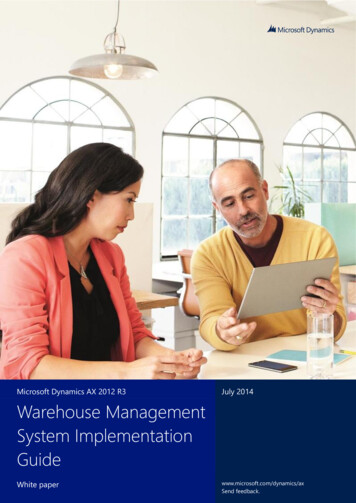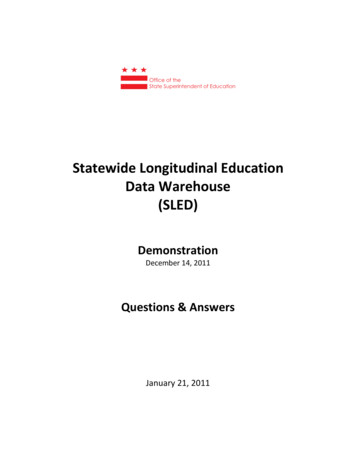
Transcription
Statewide Longitudinal EducationData Warehouse(SLED)DemonstrationDecember 14, 2011Questions & AnswersJanuary 21, 2011
Table of ContentsI. Document Purpose.3II. Acronyms & Definitions .3III. Answers to Common Questions .3A. How will SLED integrate with Local Education Agency’s (LEA) Student Information Systems(SISs)? . 3B. What does it mean to integrate SLED with LEA SISs? . 4C. Which are the most commonly used SISs in DC and are they SIF compliant? . 41. What is the Current LEA Roster Integration Process? . 42. Why is OSSE pulling data from PCSB (OLAMS) and not the LEA SISs at this time? . 5D. What is the plan to roll out Unique Student Identifiers? . 5E. When will the Special Education System (SEDS) include USIs? . 5F. In what other ways will the USI be used in SY 2011/12? . 5G. When will the SLED be online and available for LEAs to use? . 6IV.SLED Demonstration Questions & Answers.6V.SLED Team Contact Information . Error! Bookmark not defined.SLED Demonstration Q&A2
I.Document PurposeThis document provides answers to questions raised during the Statewide LongitudinalEducation Data (SLED) warehouse demonstration on December 14, 2010. Please sendadditional questions to sled.info@dc.gov.II.Acronyms & DefinitionsThe following is a list of relevant acronyms and their associated 101112PCSPCSBSEDSSIFSISSLEDIII.DefinitionDistrict of ColumbiaDistrict of Columbia Public SchoolsEnglish Language LearnerFamily Education Rights and Privacy ActLocal Education AgencyDistrict of Columbia’s Office of the State Superintendent ofEducationPublic Charter SchoolsDC Public Charter School BoardOSSE’s Special Education Data SystemSchool Interoperability FrameworkStudent Information SystemStatewide Longitudinal Education Data WarehouseAnswers to Common QuestionsThe following are consolidated answers to commonly raised questions:A.How will SLED integrate with Local Education Agency’s (LEA)Student Information Systems (SIS)?The original vision and goal of the SLED was to establish SIF (SchoolInteroperability Framework) integration with each LEA’s SIS. However, based onOSSE’s experience with SIF during the first SLED iteration and other state SIFimplementation experiences, OSSE is investigating multiple options for how tobest integrate with LEA’s systems. It is our goal to leverage the work done andSLED Demonstration Q&A3
resources already in place to determine the best approach moving forward. TheSLED integration schedule with LEAs will be determined at a later date.B.What does it mean to integrate SLED with LEA SISs?In order to integrate directly with a SIS, the SLED team must gather requirementsto understand the types of data that can and will be transferred between thetwo systems. When integration between SLED and LEA SISs is complete,electronic and automatic data integration will be possible. For example, whenstudent data is provided to SLED from the SIS, the SLED will create a USI for astudent and return the USI to the SIS.C.Which are the most commonly used SISs in DC and are they SIFcompliant?The two most popular SISs in the DC education environment are eSIS (known asDCSTARS and used by DCPS) and PowerSchool (used by approximately 40 PCSLEAs). Both of these SISs are SIF compliant, meaning that these products havebeen certified by the SIF Association to meet the needs of the SIF specifications.Several other SISs exist such as Go.Edu (used by approximately 12 LEAs),Blackbaud, STI, Administrative Plus, PCR, School Minder and Catalyst. Thefollowing URL on the SIF organization website provides a list of the SIF compliantSISs: .D.What is the current LEA roster integration process and how willSLED get data from PCSs in the future?The current LEA roster integration process used to load student demographicdata into the SLED and student demographic and enrollment data into SEDSinvolves OSSE receiving data from DCPS and PCSB daily (DCPS) and twice a week(PCSB). This process helps to streamline the data exchange between OSSE andPCSs.The SLED aims to eventually provide the following three options for receivingLEA data:1. PCSB data file integration into the SLED (via OLAMS/ProActive);2. Integration between the SLED and LEA SISs; and/or3. Manual data entry by LEAs.SLED Demonstration Q&A4
Note: PCSB data file integration with the SLED will be the primary process forreceiving PCS demographic and enrollment data until SLED/SIS integration is inplace.E.What are the benefits of OSSE pulling data from PCSB (OLAMS)?1. Streamlines data exchange as OLAMS provides data electronically to bothSLED and SEDS;2. Eliminates the need for LEAs to provide the same data to multiple sourcesystems; and3. Enables the provision of the USIs to PCSB and DCPS to be loaded intoOLAMS/ProActive and DCSTARS, respectively.F.What is the plan to roll out the Unique Student Identifiers?The USI will become the state identifier for all students attending a DC LocalEducation Agency (LEA) starting school year 2011/2012. At that time, OSSE willno longer assign DCSTARS IDs to new public school students.G.When will the Special Education System (SEDS) include USIs?The SLED will provide the USIs to SEDS starting school year 2011/12. In addition,various SEDS data such as the ability to identify students that are receivingspecial education services will be identified in SLED. In order to assist with thetransition from the DCSTARS IDs to the USI during school year 2011/2012, OSSEwill provide additional training and communication to LEAs during the summerof 2011.H.In what other ways will the USI be used in 2011/12?The USI will be used on the DC CAS precode ID labels (pre-slugging) beginningschool year 2011/2012.***In order for OSSE to properly plan this release we would like to hear directlyfrom LEAs regarding any concerns/issues that LEAs may have regarding USIsreplacing DCSTARS IDs in SEDS, including any LEA system impacts. Please emailus at sled.info@dc.gov no later than February 18, 2011.SLED Demonstration Q&A5
I.When will the SLED be online and available for LEAs to use?OSSE plans to provide LEAs with online access to the SLED during the summer of2011. The security access to the SLED will be in accordance with FERPA. OnceLEAs have access to the SLED, each LEA will have the ability to do the following:1. Access the SLED anywhere internet access is available;2. Run respective LEA reports and queries of the SLED data based on eachuser’s access levels;3. Access student-level data available; and4. Sort data and generate various types of reports.As additional functionality is added to the SLED with each release, more data andreports will be available to the LEAs.IV.SLED Demonstration Questions & AnswersThis section provides responses to questions asked by participants during the SLEDdemonstration:1. Question: Can we get copies of these slides?Answer: The presentation has been provided to all participants and it is availableon the OSSE SLED website seoNav GID,1507,seoNav, 31195 ,,.asp.2. Question: Will the USI take the place of the STARS ID? If so, will this transfer toSEDS so the students only have one ID number?Answer: Refer to Section III item G (When will SEDS include USIs?) for a detailedresponse.3. Question: What's the EPcode field on the right under the enrollment audithistory?Answer: The EPcode stands for English Language Learner (ELL). The SLED willreplace EPcode with ELL.4. Question: Does SLED take the place of OLAMS? Or will we need to continue touse both systems?Answer: SLED will not replace OLAMS. Further, OLAMS is maintained by PCSBwhile the SLED is maintained by OSSE. Please refer questions about OLAMSdirectly to PCSB.SLED Demonstration Q&A6
5. Question: Which ID will be on the DC CAS precode ID labels this year? If it is thenew USI, will schools get lists of USIs so that they can correctly match up theirdata?Answer: The DC STARS ID will be used on the DC CAS precode ID labels duringschool year 2011/2012. The USI will be used on the DC CAS precode ID labelsbeginning school year 2011/2012.6. Question: How soon will schools have access to the USI interface via SIFconnectivity?Answer: OSSE plans to make the USI interface available to users during thesummer of 2011. Refer to Section III questions A, B and I for informationregarding SIF integration and availability.7. Question: Does the student view include Special Education and ELL status?Answer: The requirements for special education and ELL status are currentlybeing determined and will be included in the SLED.8. Question: Will we need to continue to use OLAMS and SLED and SEDS as threeseparate data systems?Answer: The SLED is not a transactional system, which means LEAs will not useSLED to enter student data as is done with an SIS and OLAMS. The SLED willserve as a reporting tool for educational data analysis by gathering data fromvarious source systems into a single unique repository (data warehouse) withhistorical reporting and the ability to link data across systems via the USI. SEDSwill continue to be the source system for special education data. Refer toQuestion 4 for additional information related to this topic, as well Section IIIquestions A, B, E, F, G and I.9. Question: How does this affect students enrolled in special education?Answer: See the answer to Question 8 (above) and refer to Section III question Gfor a detailed response.10. Question: Will requests go out at later stages of development such as the earlychildhood/adult ed roll out to get input from schools or other stakeholders?Answer: During the requirements gathering phases of each release, the SLEDteam will meet with stakeholders to gather requirements.11. Question: Before it was important to have a SIF enabled SIS.Answer: Refer to Section III questions A, B and C for a detailed response.SLED Demonstration Q&A7
12. Question: Do you have a list of SIF enabled SISs for us, if that will still be arequirement?Answer: The following link has a list of SIF certified t.asp.13. Question: Will we be able to download PowerSchool directly to SLED, and viceversa?Answer: Refer to Section III questions A, B and C for a detailed response.14. Question: Exit/Withdrawal codes: Will they match the ones we're currently usingfor OLAMS?Answer: OSSE will issue an Exit/Withdrawal Policy during the spring of 2011.OSSE is working with PCSB to ensure alignment.15. Question: How does this affect students with IEPs?Answer: Refer to Section III Question G for a detailed response.16. Question: How does this impact the use of Inform?Answer: PCSB will provide Inform a crosswalk document that can be uploadedinto Inform to keep the integrity of the data and the alignment of students.Please refer all additional Inform related questions to PCSB.17. Question: If OSSE is not assigning DCSTARS IDs, who will and what measures willbe put in place to ensure no duplicates?Answer: Regarding duplicates, the SLED will create reports containing duplicativeenrollments (students enrolled at more than one school simultaneously). It willbe the responsibility of the LEAs/schools to resolve the enrollment of thestudent(s) in question. Further details regarding the resolution process will beprovided by OSSE. Refer to Section III question F for additional information.18. Question: Will actual test score reports be electronically available for individualstudents within the SLED?Answer: DC CAS assessment details (including strand level) will be incorporatedwithin the SLED during Release 3: 360 Student View Part 1. This release has anestimated 2012 release.19. Questions: Can you talk more about the process for integrating data fromvarious student information systems to SLED? Will that process be automated atsome point or will schools need to provide rosters to the system?Answer: Refer to Section III questions A, B, D, E, F and I for a detailed response.SLED Demonstration Q&A8
20. Questions: Will we be able to run respective LEA reports and queries as thoseseen for statewide data in the demonstration?Answer: Refer to Section III question I for a detailed response.21. Questions: Please confirm.a vendor is going to automate the interface betweenSLED and our SIS?Answer: Refer to Section III Questions A and B for a detailed response.22. Questions: How will we confirm NSLP student participants for students notreceiving TANF and food stamps? Will the process remain the same?Answer: Currently, the process will remain the same.23. Questions: What will be the function of the Front End Interface?Answer: Refer to Section III Question I for a detailed response.24. Questions: How much access will schools have to student records fromenrollment in previous schools?Answer: Refer to Section III Question I for a detailed response.25. Questions: Is the USI a completely random number or a composite of somecurrent student data elements?Answer: The USI is and will continue to be a randomly generated number.26. Comment: Not having SIF compliance as part of the system defeats the 'hardencouragement' made by OSSE when recommending schools to implement thiskind of systems.Answer: Refer to Section III question A for a detailed response.27. Question: Which school personnel are most likely to use SLED?Answer: The school personnel most likely to use the SLED will depend on thefunctionality and data available. The table below lists the probable LEA users perrelease:ReleaseData Reporting BenefitsExpected LEA UserEstimated ReleaseDateUSI EnhancementLEAs will be able to resolvedata issues online thatimpact USI assignmentAdministration,RegistrarSummer 2011Release 1: DataWarehouseData WarehouseRelease 2: DirectCertificationImprove Direct CertificationReportingSLED Demonstration r, FoodService PersonnelFall 2011Fall 20119
Release 3: 360 Student View Pt. 1Release 4: 360 Student View Pt. 2Release 5: Teacher& Staff ModuleRelease 6: EarlyChildhood, CollegeEnrollment, AdultEducationAssessment (Strand Level),Graduation, StandardizedTesting ResultsAssessment (Strand Level),Graduation, StandardizedTesting ResultsEstablish Teacher/Staff ID,Link Teacher to Student,Class, Course, TrackPerformance, StudentAchievement/PerformanceEarly Childcare Provider,Kindergarten Readiness,OST, CollegeEnrollment/Persistence,Electronic Transcripts, AdultEducationAdministration,Registrar, FoodService PersonnelAdministration,Registrar, FoodService PersonnelWinter 2012Summer 2012Administration,Registrar, FoodService Personnel,TeachersFall 2012Administration,Registrar, FoodService Personnel,TeachersWinter 201328. Question: How will students attending non-public schools for special educationpurposes (but who remain the responsibility of and "enrolled" with the LEA) behandled in SLED?Answer: These students will be associated with both the non-public school andthe LEA. The LEA will include these students on their official roster foraccountability reasons.29. Question: As is the policy now, will a student's DC CAS Scores count for thecount day school or the currently enrolled school?Answer: The answer to this question will be answered in three parts: Student Transfers After the Enrollment Audit- When a student transfersfrom one school to another school after the October 5 enrollment audit, thestudent counts toward the primarily (currently) enrolled school's testparticipation rate only. (The primarily enrolled school is the school thestudent attends during the time the DC CAS was taken.)The student’s scores are not counted in the proficiency calculation for AYPpurposes because the student has not spent the full academic year at the schoolby the state’s definition. As a result, the student’s DC CAS scores are not used togenerate the school “AYP Report” on the OSSE website. However, it is used forproficiency percentage that appears on the primarily (currently) enrolledschool’s “Report Card”. (The primarily enrolled school is the school the studentwas primarily enrolled during the time the DC CAS was taken.)SLED Demonstration Q&A10
Student Transfers to School Before Enrollment Audit- The student’s scoreswill be used to calculate AYP and report card data for the primarily enrolledschool. Student Transfers After the Enrollment Between Schools Within the SameLEA- If a student transfers within an LEA, the student counts for AYP at theLEA level and state level only.30. Question: What processes are in place to ensure the data integrity?Answer: The process for ensuring data integrity will continuously evolve. TheSLED team is currently working with DCPS and PCSB to identify a process forresolving data errors. Further, the LEA Data Management Policy recentlyreleased by OSSE, and effective January 4, 2011, highlights efforts to improvedata quality and reporting. The policy is posted on the OSSE o/section/2/release/20883.31. Question: Can you please explain what LEAs will need to enter into SLED on ourown?Answer: Refer to Section III question D and I for a detailed response.32. Question: Will parents be able to access the SLED to track their student'sinformation over time?Answer: OSSE hopes to eventually provide parents with access to their child’sinformation via SLED; however, the current three-year release schedule does notinclude plans to implement this functionality.33. Question: Do you know if Open SIS SIF enabled?Answer: The following URL on the SIF organization website provides a list of theSIF compliant SISs: .34. Question: Re: SIF . but OSSE recommended that schools go the SIF route threeyears ago. And we did.Answer: Refer to Section III question A for a detailed response.35. Question: Besides SIF, what other integration technologies are you guys lookinginto?Answer: Additional integration technologies that are being investigated includeInformatica and Sequel Server Integration Services (SSIS).36. Question: Will data be pulled from multiple data sources within a single school?SLED Demonstration Q&A11
Answer: If necessary, SLED will investigate the feasibility of integrating directlywith the source system(s).V.SLED Team Contact InformationFeel free to contact the SLED Team via email if you have any follow up questions atsled.info@dc.gov. Additionally, please email us at sled.info@dc.gov if you are interestedin participating in the Advisory Committee.SLED Demonstration Q&A12
SLED to enter student data as is done with an SIS and OLAMS. The SLED will serve as a reporting tool for educational data analysis by gathering data from various source systems into a single unique repository (data warehouse) with historical reporting and the ability to link data across systems via the USI. SEDS

